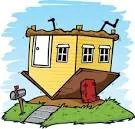Sacramento Bankruptcy & Debt Relief Attorney
Mortgage Strip-Off in Bankruptcy
Mortgage Strip-Off in Bankruptcy
A mortgage is a secured debt. If it is not repaid, the property securing the debt can be taken back by the lender. Typically a foreclosure results when the mortgage is not made. Foreclosures are addressed in other areas of this website. Suffice it to say for this topic, though, foreclosure is the process of selling your home to satisfy the debt you didn’t pay. But a mortgage can also be stripped off in a bankruptcy.
Bankruptcy can stop a foreclosure. It can prevent your home from being sold. If you want to keep your home, you will still have to pay your mortgage even if you file for bankruptcy. But bankruptcy can buy you time. It can allow you the time you need, up to five years, to get current on your mortgage. And as long as you make your bankruptcy payments, your home is protected from your bank or mortgage company.
You can also eliminate, or strip off, a mortgage through a bankruptcy. But you must establish that the loan is entirely unsecured. What this means is that the security, or collateral, for your mortgage loan is no more. Usually such a scenario results when you borrow against your home that is already mortgaged. Taking out equity in the form of a second mortgage or home equity line of credit (HELOC) are common examples. To take out such a loan there must be equity in your home. There must be at least enough equity to cover the loan. If you home was worth $175,000, and you had a $1000,000 first mortgage, you had $75,000 worth of equity to borrow against. Think of the real estate bubble or boom when “everyone” had equity and “everyone” borrowed against it. Taking out such loans was commonplace.
 But, as we all know, the real estate boom went bust. Mortgages and home equity lines of credit (HELOC) lost their collateral when the homes that secured their debt lost their equitImage result for mortgage loan upside downy. To draw from the example above, the home that was worth $175,000 may now be worth only $90,000. If so, the equity evaporated to the point where there wouldn’t even be enough to cover the first mortgage. Nothing would be left be way of security for the second. Not only would the house be underwater, the first mortgage on its own would be upside down. With no equity left to cover the second mortgage or home equity line of credit (HELOC), the loan would be entirely unsecured.
But, as we all know, the real estate boom went bust. Mortgages and home equity lines of credit (HELOC) lost their collateral when the homes that secured their debt lost their equitImage result for mortgage loan upside downy. To draw from the example above, the home that was worth $175,000 may now be worth only $90,000. If so, the equity evaporated to the point where there wouldn’t even be enough to cover the first mortgage. Nothing would be left be way of security for the second. Not only would the house be underwater, the first mortgage on its own would be upside down. With no equity left to cover the second mortgage or home equity line of credit (HELOC), the loan would be entirely unsecured.
If you have a loan that was once secured against your home but is now entirely unsecured, it can be stripped off in a bankruptcy. But this can be done only through a Chapter 13 bankruptcy. Attempts have been made to do it through a Chapter 7, but the US Supreme Court would not allow it. This NY Times story covered the case where an attempt was made to strip off a mortgage as part of a Chapter 7 bankruptcy.
If you have unsecured mortgages or home equity lines of credit (HELOC), a Chapter 13 bankruptcy may be a big benefit. Though you may have to pay a portion of it back while in your bankruptcy, it likely would be far less than what you owe on such debts if you didn’t file bankruptcy. Certainly something to consider if this situation is yours.
When you subscribe to the blog, we will send you an e-mail when there are new updates on the site so you wouldn't miss them.



